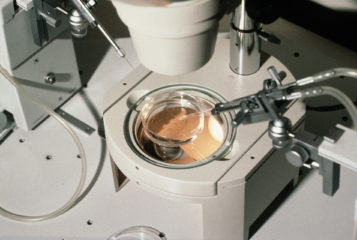More patients than ever before are accessing fertility services in the UK and thanks to advancements in clinical and laboratory practice, more patients are also achieving a pregnancy (see BioNews 1195).
In 2021, around 55,000 patients had almost 76,000 IVF cycles (incorporating both fresh and frozen embryo transfers) and around 7000 donor insemination (DI) cycles at UK-licensed fertility clinics. This puts treatment numbers back at pre-pandemic levels but more importantly, means more patients than ever before are getting the chance to try for a family.
Data from the Human Fertilisation and Embryology Authority (HFEA)'s 'Fertility Treatment 2021: Preliminary Trends and Figures' report suggests that all treatments had returned to pre-pandemic levels, with IVF and DI cycles increasing overall by ten percent from 2019 to 2021. It also shows that thanks to improved clinical and laboratory practice, the average overall pregnancy rate from IVF using fresh embryo transfers increased from ten percent per embryo transferred in 1991 to 29 percent in 2021.
Patients aged 18-34 had the highest pregnancy rate per embryo transferred at 41 percent in 2021, with pregnancy rates increasing from eight percent in 1991 to 33 percent for patients aged 35-37, and 25 percent for those aged between 38-39. The pregnancy rate per embryo transferred for patients aged 40-42 increased from six percent in 1991 to 16 percent in 2021, and for those aged 43-50, the pregnancy rate increased very slightly from one percent in 1991 to six percent in 2021.
The average IVF pregnancy rate using frozen embryo transfers has also risen to 36 percent in 2021, from around seven percent in the 1990s. This reflects a shift in clinical practice, with 41 percent more frozen IVF cycles in 2021 than there were in 2017. As freezing techniques have improved, typically patients today will have a single fresh embryo transferred during their first cycle, and any good quality embryos that remain stored for future treatment.
Over time, changes in clinic practice – together with support from the HFEA, professional bodies, patient organisations and clinic staff – have led to a decrease in multiple births. In the early 1990s, the average UK multiple birth rate from IVF was around 28 percent, compared to one-two percent in natural conception. In 2021, the preliminary average multiple birth rate decreased to an all-time low of five percent.
Importantly, birth rates have continued to rise while the multiple birth rate has fallen. This may be due, in part, to increased use of single embryos at blastocyst stage. This reduction should be celebrated across the sector, as the number of patients who are at increased risk of late miscarriage, premature delivery, gestational diabetes, stillbirth and neonatal and maternal death – and the overall cost to the NHS – has been significantly reduced.
Scientists in the UK are at the forefront of fertility treatment innovation and embryo research, and it's because of this that so many more patients are having treatment, achieving a pregnancy, and then giving birth to a baby. The average birth rate from IVF using fresh embryo transfers has increased to 22 percent in 2021, from eight percent per embryo transferred in 1991. For frozen embryo transfer, rates have increased from around six percent in the 1990s to 27 percent in 2021.
Earlier this year, the HFEA consulted on a range of proposals that aim to modernise UK fertility law (see BioNews 1181). We consulted on a range of areas, including how the HFE Act could encourage innovation. We will submit formal recommendations to the Government later this year, and will continue to call for a change in the law, to further enhance the quality of fertility treatment and patient care for years to come.
Data from the 'Fertility Treatment 2021: Preliminary Trends and Figures' report suggests that all treatments had returned to pre-pandemic levels. Fresh embryo transfer IVF increased by three percent, and frozen embryo transfer IVF increased by 18 percent from 2019 to 2021. However, despite this, our preliminary data shows a drop in access to NHS-funded IVF cycles over the same period.
The fertility sector is a unique area of healthcare in the UK, as the majority of patients pay for treatment themselves. There were just under 4000 fewer IVF cycles funded through the NHS between 2019 and 2021, so although more people are having fertility treatment, more people than ever are now also paying for it.
There could be several reasons why NHS funding levels lag behind those seen before the pandemic. First, we've seen a change in the type of family accessing fertility treatment, with clinics treating 44 percent more single patients and 33 percent more patients in same-sex female couples in 2021 than they did in 2019. Second, funding criteria vary depending on where you live. And finally, measures put in place during the COVID-19 pandemic saw clinics prioritise older patients, and this – combined with waiting list backlogs elsewhere in the NHS – could mean that patients are no longer eligible for NHS funding, by the time they are referred for fertility treatment.
The drop in patients accessing NHS-funded cycles is worrying and that's why the commitments in the Women's Health Strategy are so important (see BioNews 1152), as well as the Progress Educational Trust's Power of Three campaign.
The 'Fertility Treatment 2021: Preliminary Trends and Figures' report was published by the Human Fertilisation and Embryology Authority (HFEA) in June 2023. It provides preliminary data relating to how many patients undergo fertility treatment each year in UK fertility clinics, the type of treatment they have, and the success rate.







Leave a Reply
You must be logged in to post a comment.